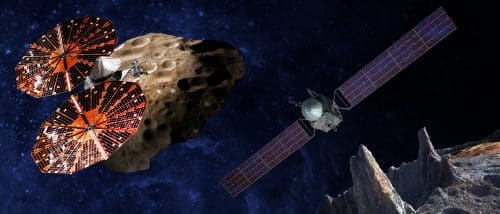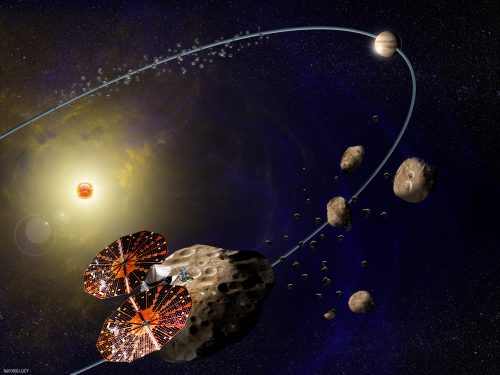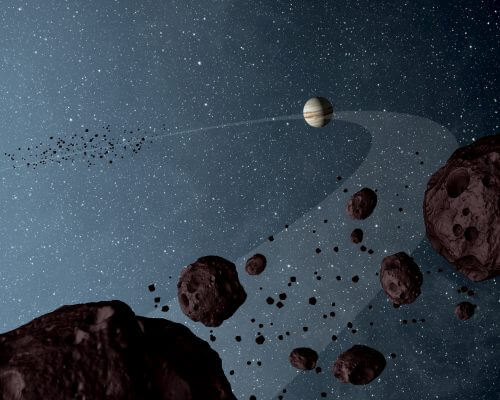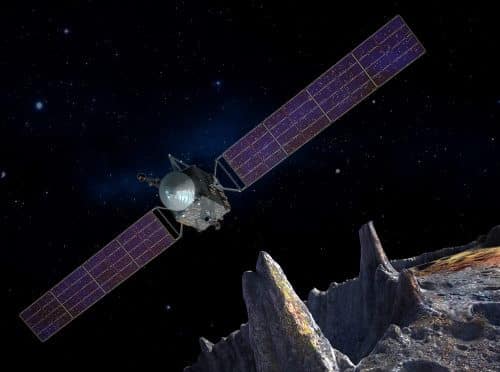NASA has announced two new space missions that will focus on the study of asteroids: Lucy, which will investigate the Trojan bodies of the planet Jupiter - mysterious asteroids that are in the same orbit as Jupiter around the Sun and follow it in front and behind. Lucy will be launched in 2021, and two years later the Seiki probe will be launched, which will investigate the metallic asteroid Psyche 16, one of the most massive bodies in the asteroid belt, which researchers assume is a remnant of the metallic core of an ancient planet, which crashed into pieces following a powerful collision in the early stages of the solar system.

NASA announced yesterday (Wednesday) two new space missions - both will focus on the study of asteroids and will try to answer key questions facing planetary research today, including: how the solar system developed in its initial stages and how the various layers in the depths of the planets were formed.
The two missions, Lucy and Psyche, were selected from five finalists from proposals submitted to the American space agency, in the competition for the next mission to be launched as part of NASA's Discovery program - which focuses on "relatively cheap" space missions, within a cost of 450 million dollars (not including the launch cost) .
Probe Lucy It is the first mission of the two and will be launched, according to the current schedule, in October 2021. It will investigate mysterious bodies in the solar system called "Trojans of Jupiter" - these are small bodies that are in the same orbit as the giant planet, and follow it back and forth. On its way to the orbit of Jupiter and the distant bodies that follow it, Lucy will pass through the central asteroid belt in 2025. Between 2027 and 2033, she will study six Trojan bodies, from the two different groups of Trojans (those that are ahead of Jupiter and those that follow it in orbit around the Sun).

These bodies have never been closely studied, but only by astronomical observations, which failed to yield sufficient information to determine the origin and composition of those bodies. Their unique orbit, before and after Jupiter in the same orbit around the Sun, is possible due to a balance between the gravity of Jupiter and the Sun, at unique points in the space of machines Points for Grange.
One of the researchers' assessments, which is included in the framework of a theory Nice model of the migration of the planets, is that those bodies originated from the Kuiper belt at the edge of the solar system, and that they were trapped in their current orbit due to the migration of Jupiter and the other gas giants in the first centuries of the solar system. This migration resulted in a shock among the primordial Kuiper belt bodies and the deflection of millions of small bodies into the inner solar system.
"This is a unique opportunity," said Harold Levison, the principal investigator of the Lucy mission from the Southwest Research Center in the state of Colorado in the United States. "Because the Trojan bodies are remnants of the primordial material from which the planets formed, they contain clues that are necessary to decipher the history of the solar system. Lucy, like the human fossil she is named after, will revolutionize the understanding of our origins," Levison added.
Similar to another mission currently operating in the Tzedek region, Juno, Lucy will operate on the basis of solar energy and not by means of a thermoelectric radioisotope generator (RTG), which produces electricity from the heat emitted by radioisotope material, and which has been used so far by spacecraft at such a great distance from the Sun - Jupiter is 5 times the distance of the Earth from the Sun, and a solar panel in its vicinity will produce twice 25 less electrical energy than on Earth.

The second task chosen is Seiki (Psyche), or Psyche in the Hebrew translation of the origin of the name from Roman mythology (the girl Psyche who married Cupid). The probe is named after the asteroid it will investigate - Psyche 16. It is one of the most massive asteroids in the asteroid belt (located between the orbit of Jupiter and the orbit of Mars), and its diameter is about 210 km.
Unlike most asteroids, which are composed of rock and ice, Psyche 16 is composed mostly of iron and nickel, and researchers speculate that it is a remnant of the inner core of Proto-planet, the primordial bodies from which the planets we know today were formed. According to the researchers' hypothesis, Psyche 16 was formed following a powerful collision that broke into pieces the primordial body from which it came.
If this hypothesis is correct, the Seiki mission will be the first time that it will be possible to study the inner core of a planet directly - since it is not possible with today's technology to reach the depths of the Earth and directly study its metallic core.
According to NASA, Seiki will help in understanding the process of planetary differentiation, in which the different layers that make up the planets were formed, including the Earth, which consists of an outer crust, a rocky shell and a core made of iron and nickel (the same composition of the asteroid Psyche 16). This process was made possible in the early stages of the solar system, when the primordial planets were melted due to the great heat generated by the many collisions in which they were formed. In this process the light materials, such as rock, floated to the top and the heavy materials, such as iron and nickel, sank down.

"This is an opportunity to explore a new kind of world — not one of rock or ice, but one of metal," said Lindy Elkins-Tanton, principal investigator of the Psyche mission at Arizona State University. She added that "Psyche 16 is the only body of its kind known in the solar system, and this is the only way humans will ever be able to visit its core. We learn about inner space by visiting outer space.”
Seiki will launch in 2023 and reach an asteroid in 2030, after a flyby of Earth in 2024 and a flyby of Mars in 2025, where it will use the gravity of both planets to boost its speed to the speed necessary to reach the asteroid belt.
It is interesting to note that in a telephone press conference where NASA announced the two missions, Harold Levison, the principal investigator of the Lucy mission, revealed that if it successfully completes its main mission and still has fuel left for a follow-up mission, it may explore other asteroids, including Psyche 16 of Seiki mission.
See a simulation of the Seiki mission near the metallic asteroid Psyche 16:
Unlike previous times, this time NASA chose two missions at the same time in a competition that was supposed to yield only one winner, this is due to the agency's desire to restore the pace of missions in the Discovery program to the beneficiary. This plan, which was supposed to launch a mission every two years on average, has been postponed in recent years due to budget difficulties. The last mission launched as part of the program was GRAIL for exploring the moon launched in 2011. Last year another mission, InSight, was supposed to be launched, a Mars lander designed to carry out seismological research on the planet, but Delayed launch For May 2018, due to a malfunction in the scientific instrument manufactured by France.
While the crew members of the selected missions are certainly celebrating now, there are many whose feelings are quite the opposite - the crew members of the three missions that were not selected. of The five that NASA chose in 2015 As "finalists" in the competition, only two won. One of the proposals that was not selected was the mission proposal Near Earth Object Camera – A telescope that will detect small asteroids near the Earth that may collide with it.
But the main disappointed are the fans of the planet Venus - which was neglected by NASA for many years. The US Planetary Agency's last mission was Magellan in the 90s, which provided global radar images of the planet, allowing for the first time to see what the surface of Venus looks like, beneath its very dense atmosphere. The other two proposals that did not win the competition focused on the study of Venus - one proposed to send a mission essentially similar to that of Magellan - but of much higher quality, and the other proposed to land a probe that would descend to the surface of the earth and study the composition of Venus' atmosphere.
Jim Green, a senior administrator at NASA, pointed out that Venus researchers should not give up yet - they will have another opportunity to submit research proposals for competition in the next mission of another and more prestigious program - the "New Horizons" program - from which the New Horizons missions to Pluto and G 'Veno to justice. These missions receive a much higher budget than Discovery missions, but their frequency is lower. The current competition is now in its infancy, with NASA expected to announce the finalists in November of this year, and announce the successful winner only in 2019, with a launch target of 2024.
Meanwhile, NASA also announced a mission Another and separate one that will be launched in 2020. This mission will be launched as part of NASA's Astrophysical Research Unit, and its total budget will be 188 million dollars. The spacecraft, Imaging X-ray Polarimetry Explorer, will include three X-ray telescopes to study the most powerful objects known to science today - supermassive black holes, neutron stars and pulsars.

7 תגובות
to the opponent
The simplest. The spacecraft maintains an orbital velocity that leaves
It is in free fall near the asteroid.
Elisaf and Nisim, thanks for the answers,
Miracles when I said that the engines will emit the plate gases at an angle of 30 degrees, that's exactly what I meant. In my opinion the most practical idea is to wrap the asteroid in a large net and then turn on the spacecraft's engines and slowly drag it sideways to another orbit.
It appears in the video.
rival
There is a simple solution - instead of one motor you will mount two motors with a small angle between them. This will give radial thrust to the asteroid and the exhaust gases will not hit the asteroid.
Don't forget that in any case the exhaust gases have dispersion and at a great distance only a small part of the gas will hit the asteroid.
You are probably talking about the Asteroid Redirect Mission proposal, which there is a good chance that it will not become more than a proposal.
Regarding what you are asking, maybe the mission video will help, at minute 2:00 they show the process of the asteroid's deflection:
https://www.youtube.com/watch?v=3UkEximY6lc
Thanks, although it still doesn't work for me. To exert an attraction on him she would probably have to be several meters away from him, and that means he takes up almost all of her rear field of vision. So even if its engines eject the gases at an angle of 30 degrees from the central axis it will still create a push force on the asteroid which I think will be even stronger than the force of attraction between them.
Does anyone know the English term for this towing method? I want to see it visually, I searched YouTube for "Astroid dragging" and I can't find any video.
The exhaust gases can only affect the asteroid if they are aimed in its direction and hit it. It is not difficult to bring the spacecraft to its desired position and direction without directing the exhaust gases towards the asteroid. In addition to this, even if the exhaust gases do hit the asteroid, it must be assumed that their action on the asteroid will not completely cancel out the benefit of changing the spacecraft's vector.
I have a question for those in the know, there is a lot of talk about the possibility of a spacecraft flying near an asteroid and exerting a small gravitational force on it that will slowly move it away from a collision course with the Earth, but something about this method is incomprehensible to me, just as the spacecraft attracts the asteroid, so it also attracts it to him, and eventually they will stick together, to prevent this the spacecraft will have to turn on its engines for a short time to move away from it, but then the exhaust gases coming out of the spacecraft will push the asteroid in the opposite direction, canceling all the pulling effect it exerted on it before, right? So how does it work out?